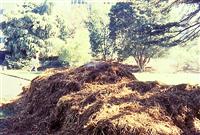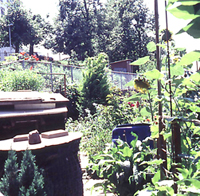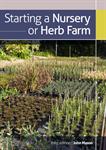 A Basic Guide To Home Composting
A Basic Guide To Home Composting
Composting is important to the natural garden as it enables us to recycle organic matter that would otherwise be thrown away. Any organic matter, if left long enough will eventually rot away, but by composting, we can speed up the rate of decomposition, and be left with a good source of natural plant food.
|
C:N ratios of some common compost materials
|
|
Chicken Manure
|
7:1
|
|
Lucerne hay
|
13:1
|
|
Cow manure
|
15:1
|
|
Food Waste
|
15:1
|
|
Weeds
|
19:1
|
|
Lawn clippings
|
20:1
|
|
Seaweed
|
25:1
|
|
Fruit waste
|
35:1
|
|
Leaves
|
60:1
|
|
Straw
|
100:1
|
|
Paper
|
170:1
|
|
Eucalypt bark
|
250:1
|
|
Sawdust
|
450:1
|
|
Pine bark
|
500:1
|
The Carbon:Nitrogen ratio
Gardening books will frequently refer to an elusive C:N ratio, particularly when they are talking about composts. The most important requirement for effective decomposition in the home compost is the ratio of carbon (C) to Nitrogen (N) in the materials.
This is called the Carbon-Nitrogen (or C:N) ratio. C:N ratios are sometimes written as a ratio, such as ’20:1’. Other times they are written as a simple number, since the ratio always refers to the quantity of carbon for each one unit of nitrogen.
The C:N ratio of a freshly made compost should be about 30:1. The C:N ratio of a finished compost is usually more like 10 or 20:1, since the carbon is utilized by organisms as they compost the materials
To get a suitable C:N ratio it is necessary to mix materials with a high C:N ratio such as sawdust, with materials such as manures that have a low C:N ratio. It is not necessary to get out the chemistry equipment and measure the C:N ratio of the compost as you make it, but you should think about the approximate quantities of carbon and nitrogen in the materials you use. The table provides some C:N ratios for common materials that might be added to home composts. It is perfectly acceptable to make guesses about other materials, based on this table and what the material looks, smells, and feels like.
Compost needs the following:
- Plenty of organic matter.
- Sufficient nutrients, particularly nitrogen ‑ The bacteria that break down material in the compost need Nitrogen to survive. If the Nitrogen levels become too low then they will die out.
- Sufficient, and well dispersed oxygen ‑ to speed up the rates of decomposition. Oxygen can be added to a compost heap by using ventilated pipes running through the heap to introduce oxygen, or by turning the compost regularly.
- Sufficient and well dispersed water ‑ The compost should have the moisture content of a squeezed sponge, damp but not soggy. If the compost is too dry, water can be added to the compost when it is turned. If the compost is too wet, drainage pipes can be placed underneath, or the compost can be turned more readily.
- A source of cations - especially calcium, to stabilize the compost. The calcium will act as a buffer to stop pH levels from varying to much. Gypsum is sometimes added to compost heaps as a source of calcium at the rate of 1‑3kg per cubic metre of compost. Gypsum also has the effect of reducing odours and reducing nitrogen losses.
- Appropriate temperature ‑ For the compost heap to decompose effectively, the heap needs to reach a heat of between 40 and 60 degrees C. This heat is generated by the 'body' heat given off by the microbes in the heap.
- Appropriate pH ‑ as plant sap is acidic, compost heaps will start off acidic and may even become more acidic in the early stages of decomposition, but this will return back to earlier levels later.
- · Moist or juicy material should be in thin layers (no more than 3cm thick) covered by dry organic material such as dry straw or shredded paper
- · The layers of organic material should be between 5 and 10cm thick when first laid down (note that as the heap settles this will settle.)
- · If using a large amount of cooked food, or dry material such as straw, wood shavings or paper, add some manure to boost the levels of nitrogen in the composting material.
 Compost bins
Compost bins
Compost bins are useful as a tidy way of making compost, and will fit well in many urban situations. In direct sun, the plastic can trap heat, speeding the decomposition process, but can sometimes get too hot. The plastic bin also holds in moisture well, but can sometimes get too moist.
‘Worm farms’
When earthworms feed, they work with raw materials and turn them into rich fine compost. This compost is rich in castings or manure of the earthworms which is superior to animal manures. Worm ‘farms’ can be purchased or made from just about any sort of container that will hold the worms and the material they are being fed on, but will allow drainage. Worms can be fed kitchen scraps, straw, manure, paper, etc. An example of the proportions of materials is: 70% weeds, leaves, grass clippings, 25% manure and or table wastes; 5% topsoil. It is advisable to use purchased worms as they thrive best under domestic conditions. Tiger worms or red wrigglers are two of the best varieties. The worm farm should be kept moist but not saturated, and ideally should be maintained at a standard temperature (not to hot and not too cold) with as little temperature fluctuation as possible. It is the combined action of the earthworms, bacteria and fungi that produces the best kind of compost.
The Finished Product
 Compost is ready to use when:
Compost is ready to use when:
- It is crumbly and generally an even texture (Material such as straw, or flower stems might be intact still, but will frequently crumble when squeezed between the fingers).
- It should drain well, but still have good moisture holding capacity.
- It should be dark in colour
- It should smell earthy, not rotten or mouldy.
- The high temperatures that occurred in the centre of the heap during decomposition should have dropped.
Compost can be used either as a mulch, spread on the surface of the ground, or dug in (mixed with soil), to improve the structure of soil. Compost can be applied at almost any time of the year, but best results will frequently be had if it is applied in autumn or spring, and dug into the topsoil. Do not leave compost too long before using it, as nutrients can be lost over time – particularly in warm wet weather.
HOW TO LEARN MORE
See our Newsletters (click) -and subscribe
See our Gardening, Landscaping and Horticulture Courses (click) -and browse
Use our FREE COURSE & CAREERS ADVISORY SERVICE (click) and apply
Browse our Bookstore www.acsebook.com/ -see titles published by this school and written by our staff

- Quality ebooks written by our staff
- Wide range of Horticulture titles by John Mason, author of over 40 gardening books, garden magazine editor, nurseryman, landscaper and principal of ACS.
- Ebooks can be purchased online and downloaded straight away.
- Read on an ipad, computer, iphone, reader or similar device.
- New titles published every month –bookmark and revisit this site regularly
- Download sample pages for free, to see what each book is like.
More from ACS
Ebook - Decide what you can produce in your garden and the growing conditions needed for a range of climates.
View eBook
Ebook - comprehensive, easy to read guide on all the aspects of organic growing.
View eBook
100 hrs, self paced, incorporates a Permaculture Design Certificate
View Course
Course - More and more people are gaining an interest in how to live a more sustainable lifestyle - this course helps you and in turn you can help others.
View Course
Course - help the environment by understanding the principles and practices of cultivating plants naturally without the use of chemicals.
View Course